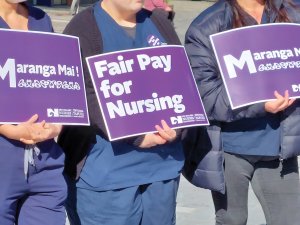Respiratory physician Lutz Beckert considers chronic obstructive pulmonary disease management, including the prevention of COPD, the importance of smoking cessation and pulmonary rehabilitation, and the lifesaving potential of addressing treatable traits. He also discusses the logic of inhaler therapy, moving from single therapy to dual and triple therapy when indicated, as well as other aspects of management
Backlash at Te Whatu Ora request to survey practices on nurses’ pay
Backlash at Te Whatu Ora request to survey practices on nurses’ pay

On behalf of our sector, any form of funding that’s available is better than no funding
A draft Te Whatu Ora survey asking general practices what they pay their nurses is on hold after being widely criticised by general practice leaders for seeking commercially sensitive information.
Due to be sent out this week, the survey is part of assessing whether practices will get a share of the government’s $200 million-a-year nurse pay disparities’ funding pot from 1 July.
It appears to be on hold after strong feedback from the three Contracted Provider Caucus organisations, which said Te Whatu Ora shouldn’t ask practices to share confidential nurse pay information.
Te Whatu Ora officials are expected to advise health minister Ayesha Verrall by the end of this month on whether general practices are eligible for the second tranche of the funding.
The General Practice Owners Association sent an email to members on Monday morning slamming the disparity fund process and recommending practices not provide the requested data.
Chair Tim Malloy also sent a letter yesterday to Te Whatu Ora director of commissioning Abbe Anderson objecting to the fund’s “flawed” approach that failed to address parity with practice nurses’ hospital colleagues.
That includes Te Whatu Ora requiring funding to “100 per cent” go on nurse pay. GenPro says this would penalise employers who cut services and income so they could pay above primary care pay deal rates and retain their nurses.
GenPro also argues it would lock in lower pay rates for nurses whose employers who can’t afford to pay above the current primary health care multi-employer collective agreement (MECA) rates.
GenPro chief executive Philip Grant told New Zealand Doctor Rata Aotearoa he talked with Te Whatu Ora officials this morning over the concerns and understands the survey is on hold while changes are considered.
“They have clearly picked up that there is limited support from the sector for what they are trying to do,” Mr Grant says.
“We can’t support a survey that is part of a bigger flawed process.”
He says Te Whatu Ora is proposing practices receive a share of the $200 million fund to “reduce the pay gap” created by the average 14 per cent pay equity increase that hospital nurses got in March. But it is not intending to fund the up to 27 per cent pay parity gap between the primary care MECA and current hospital nurse pay rates.
Hauora Taiwhenua Rural Health Network chief executive Grant Davidson says the network and fellow caucus member, the RNZCGP, also provided feedback yesterday to Te Whatu Ora about the draft survey.
Dr Davidson said the network was “very wary” and concerned that some of the survey questions were potentially commercially sensitive and raised privacy issues.
“We don’t believe they need that information [on specific pay rates], all they need is the number of nurses at the various steps,” he says.
He agrees the $200 million will not resolve the “massive” practice nurse pay parity issue and has clearly stated these concerns to Te Whatu Ora.
But Dr Davidson says it’s in the best interest of its practices to take a “pragmatic” approach over getting some funding towards reducing the gap.
“On behalf of our sector, any form of funding that’s available is better than no funding, in our mind.” He says the network sees accepting the funding as without prejudice to addressing the bigger issue of the large pay parity gap.
RNZCGP chief executive Lynne Hayman confirmed via text that the college provided feedback to Te Whatu Ora on the survey yesterday.
But neither Mrs Hayman nor RNZCPG president Samantha Murton wanted to comment further at this stage.
General Practice NZ joined the three caucus organisations in meetings with Te Whatu Ora in recent weeks to discuss the process of how practices might access the disparities fund.
Chief executive Maura Thompson says Te Whatu Ora has been quite clear that this is not going to settle complete pay parity and that other conversations still need to happen.
This is one part of a much bigger jigsaw in terms of practice funding and workforce investment, says Ms Thompson.
New Zealand Aged Care Association chief executive Simon Wallace says general practice nurses are equally deserving of accessing the $200 million a year fund.
Mr Wallace adds the fund is way too small to be spread across an additional four to five thousand additional nurses and that would leave “everybody short-changed”.
The residential aged care sector was eligible for the initial $40 million tranche but he says the $20.1 million share it received was less than half of what it needed to match the new Te Whatu Ora pay equity rates for nurses.
It had also not stopped Te Whatu Ora poaching aged care nurses and he says if Dr Verrall does not fully fund pay parity there could be even more pressure on hospital beds this winter because of closed beds in the aged care sector due to nurse understaffing.
Te Whatu Ora tagged the aged care disparities funding to be spent on nurse pay only. His organisation successfully negotiated for providers already paying nurses more to use the funding for penal rates, shift allowances and professional development.
New Zealand Doctor has asked Te Whatu Ora for information on the survey and disparities fund process but had not received a response at time of publication. [A response was received the morning of 19 April - see in comments below]
We're publishing this article as a FREE READ so it is FREE to read and EASY to share more widely. Please support us and the hard work of our journalists by clicking here and subscribing to our publication and website







![Barbara Fountain, editor of New Zealand Doctor Rata Aotearoa, and Paul Hutchison, GP and senior medical clinician at Tāmaki Health [Image: Simon Maude]](/sites/default/files/styles/thumbnail_cropped_100/public/2025-03/Barbara%20Fountain%2C%20editor%20of%20New%20Zealand%20Doctor%20Rata%20Aotearoa%2C%20and%20Paul%20Hutchison%2C%20GP%20and%20senior%20medical%20clinician%20at%20T%C4%81maki%20Health%20CR%20Simon%20Maude.jpg?itok=-HbQ1EYA)
![Lori Peters, NP and advanced health improvement practitioner at Mahitahi Hauora, and Jasper Nacilla, NP at The Terrace Medical Centre in Wellington [Image: Simon Maude]](/sites/default/files/styles/thumbnail_cropped_100/public/2025-03/2.%20Lori%20Peters%2C%20NP%20and%20advanced%20HIP%20at%20Mahitahi%20Hauora%2C%20and%20Jasper%20Nacilla%2C%20NP%20at%20The%20Terrace%20Medical%20Centre%20in%20Wellington%20CR%20Simon%20Maude.jpg?itok=sUfbsSF1)
![Ministry of Social Development health and disability coordinator Liz Williams, regional health advisors Mary Mojel and Larah Takarangi, and health and disability coordinators Rebecca Staunton and Myint Than Htut [Image: Simon Maude]](/sites/default/files/styles/thumbnail_cropped_100/public/2025-03/3.%20Ministry%20of%20Social%20Development%27s%20Liz%20Williams%2C%20Mary%20Mojel%2C%20Larah%20Takarangi%2C%20Rebecca%20Staunton%20and%20Myint%20Than%20Htut%20CR%20Simon%20Maude.jpg?itok=9ceOujzC)
![Locum GP Helen Fisher, with Te Kuiti Medical Centre NP Bridget Woodney [Image: Simon Maude]](/sites/default/files/styles/thumbnail_cropped_100/public/2025-03/4.%20Locum%20GP%20Helen%20Fisher%2C%20with%20Te%20Kuiti%20Medical%20Centre%20NP%20Bridget%20Woodney%20CR%20Simon%20Maude.jpg?itok=TJeODetm)
![Ruby Faulkner, GPEP2, with David Small, GPEP3 from The Doctors Greenmeadows in Napier [Image: Simon Maude]](/sites/default/files/styles/thumbnail_cropped_100/public/2025-03/5.%20Ruby%20Faulkner%2C%20GPEP2%2C%20with%20David%20Small%2C%20GPEP3%20from%20The%20Doctors%20Greenmeadows%20in%20Napier%20CR%20Simon%20Maude.jpg?itok=B0u4wsIs)
![Rochelle Langton and Libby Thomas, marketing advisors at the Medical Protection Society [Image: Simon Maude]](/sites/default/files/styles/thumbnail_cropped_100/public/2025-03/6.%20Rochelle%20Langton%20and%20Libby%20Thomas%2C%20marketing%20advisors%20at%20the%20Medical%20Protection%20Society%20CR%20Simon%20Maude.jpg?itok=r52_Cf74)
![Specialist GP Lucy Gibberd, medical advisor at MPS, and Zara Bolam, urgent-care specialist at The Nest Health Centre in Inglewood [Image: Simon Maude]](/sites/default/files/styles/thumbnail_cropped_100/public/2025-03/7.%20Specialist%20GP%20Lucy%20Gibberd%2C%20medical%20advisor%20at%20MPS%2C%20and%20Zara%20Bolam%2C%20urgent-care%20specialist%20at%20The%20Nest%20Health%20Centre%20in%20Inglewood%20CR%20Simon%20Maude.jpg?itok=z8eVoBU3)
![Olivia Blackmore and Trudee Sharp, NPs at Gore Health Centre, and Gaylene Hastie, NP at Queenstown Medical Centre [Image: Simon Maude]](/sites/default/files/styles/thumbnail_cropped_100/public/2025-03/8.%20Olivia%20Blackmore%20and%20Trudee%20Sharp%2C%20NPs%20at%20Gore%20Health%20Centre%2C%20and%20Gaylene%20Hastie%2C%20NP%20at%20Queenstown%20Medical%20Centre%20CR%20Simon%20Maude.jpg?itok=Z6u9d0XH)
![Mary Toloa, specialist GP at Porirua and Union Community Health Service in Wellington, Mara Coler, clinical pharmacist at Tū Ora Compass Health, and Bhavna Mistry, specialist GP at Porirua and Union Community Health Service [Image: Simon Maude]](/sites/default/files/styles/thumbnail_cropped_100/public/2025-03/9.%20Mary%20Toloa%2C%20Porirua%20and%20Union%20Community%20Health%20Service%20in%20Wellington%2C%20Mara%20Coler%2C%20T%C5%AB%20Ora%20Compass%20Health%2C%20and%20Bhavna%20Mistry%2C%20PUCHS%20CR%20Simon%20Maude.jpg?itok=kpChr0cc)